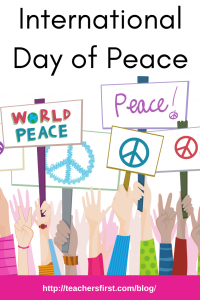The International Day of Peace, established in 1981 by the United Nations General Assembly, is celebrated worldwide every September 21. This year’s theme is “End racism. Build peace.”
International Day of Peace provides a powerful opportunity to engage youth in diverse peace-related activities that can inspire them to make a positive difference in their world. A.K. Chowdhury, former UN Under-Secretary-General & High Representative and former head of UNICEF, said it best, “A key ingredient in building a culture of peace is education.” When students and adults alike are given opportunities to explore and learn about the lives of others around the world, they are better able to develop empathy and compassion.
Literature can help improve students’ global understanding. Books can launch our students into a voyage of discovery, allow them to explore other ways of being, and bring clarity to their worldview. Classified by theme and grade level, some TeachersFirst CurriConnects collections are perfect for sparking discussions about understanding others:
- CurriConnects Book List – Childhood Here and There shares tales of childhood in many cultures and countries
- CurriConnects Book List – Real Life in Wartime shares how real people experienced the conflicts of the 20th century.
- CurriConnects Book List – Immigrants and Immigration includes books about life as an immigrant in America.
Whether you use one of the texts from the collections above or another medium to foster openness to other cultures, you’ll want to provide students with opportunities to synthesize and share their thoughts.
- You can use a Twitter Chat to facilitate a digital classroom discussion with secondary students. Twitter chats not only encourage digital literacy but offer a way to track participation through the chat hashtag easily. Younger students or those who need a walled-garden approach can try Twiducate (reviewed here).
- Flip (reviewed here) offers a video discussion option to connect and discuss their thoughts on the texts. If you are unfamiliar with Flip or want a refresher on how to use it, you can watch this OK2Ask recording on Creating Classroom Communities with Flip.
- Thinking Routines like “Seek to See” encourage students to take an empathic perspective when analyzing texts, images, or videos. Students can share their responses to the guided questions on a digital bulletin board like Padlet (reviewed here).
- Use an application like Word Art (reviewed here) to create art using phrases and words from the text that most resonated with students. You can choose to create a variety of different shapes, including a peace sign!
Celebrating Peace Day doesn’t need to be a huge lesson. Simply discussing what the day means and why it’s important is more than sufficient. Please explore the Peace Day resources below that offer various classroom activities.
- U.N. International Day of Peace Global Peace Day Activities
- 15 International Peace Day Activities
- Peace Poems and Picasso Doves: Literature, Art, Technology, and Poetry
- The Peace Journey: Using Process Drama in the Classroom
Whether you choose a powerful lesson or a simple class discussion, make a point to share in celebrating this day with your students, then come back to this post and leave a comment explaining how you promoted peace with your students.


